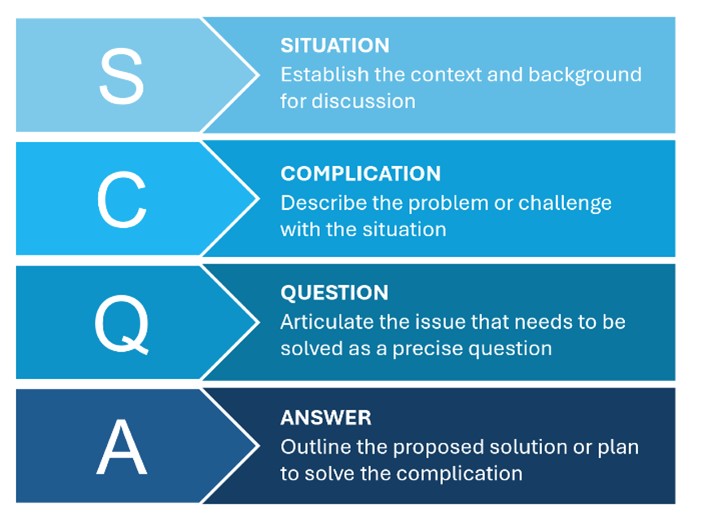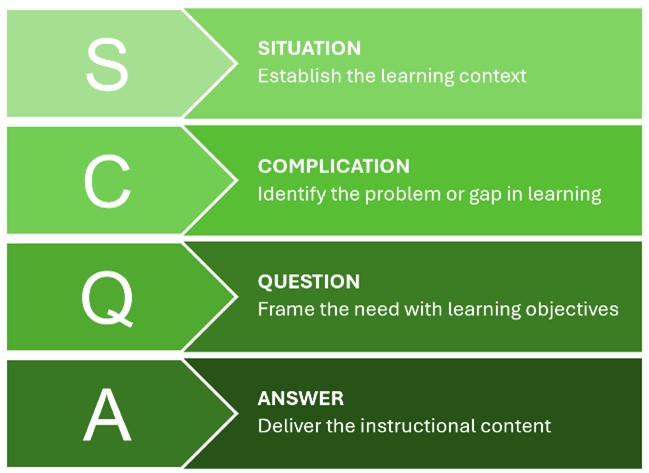In my last article, Bored Learners? Use SCQA Framework to Grab & Sustain Their Interest, I talked about the SCQA framework and explained how its individual components (Situation, Complication, Question, and Answer) help build a naturally progressing storyline that enables the audience to deeply immerse in the contents of the message and experience higher levels of engagement.
In this article, I will build on that understanding and explain how the SCQA framework can be applied to the field of instructional design and training.

1. Situation (S): Establishing the learning context
In instructional design, the Situation component of the SCQA framework can help set the stage for learners by defining the current state of knowledge. It can be used to describe the relevant context based on the topic of the training or to provide scenarios that set up the foundation of learning for the target learners.
Instructional designers can use the Situation to provide learners with a clear understanding of the starting point, review familiar background, or even describe any pre-existing knowledge required to engage with the learning material.
For example, if you're designing a leadership training program, you could begin by explaining that effective leadership is critical for driving organizational success, employee engagement, teamwork, and innovation and mention that, however, many leaders rely on outdated leadership models or struggle with adapting to modern, dynamic work environments.
Next, you can present real-world scenarios where leadership plays a pivotal role, such as leading through change, managing diverse teams, handling complex stakeholder relationships, or dealing with workplace conflicts. This allows learners to connect with the material from the outset.
2. Complication (C): Identifying the problem or gap

The Complication is where the complexity or challenge is introduced—and where the gap between the current state and the desired state is highlighted. From a learning perspective, this component of the SCQA framework represents the problem that the learners need to solve or the knowledge they need to gain.
Instructional designers can use the Complication to highlight why the learner's current understanding or skillset is insufficient. This can be framed as a challenge they will overcome through the training, thereby making the learning more engaging and motivating. Continuing our example:
In the leadership training program, this is where you can introduce the challenge that leaders often face, highlighting the gap between the current leadership practices and what is needed for success. This step brings the learner's attention to why their current approach may be inadequate.
For instance, "Many leaders struggle to build trust and credibility within their teams, especially in today's hybrid or remote work environments. Additionally, balancing empathy with decision-making authority is often a challenge for new leaders."
By outlining the leadership challenges learners face in their work settings, and by emphasizing the real-world difficulties of balancing various leadership styles, team dynamics, and stakeholder expectations, you can set the stage for what learners need to resolve. This increases engagement by showing learners how the training is directly applicable to their work.
3. Question (Q): Framing the need through learning objectives
Once the complication is clear, the Question arises naturally: "How can we address this problem or gap?" In instructional design, this is where the ID would define the specific learning objectives or the central question that the learning content will answer.
Continuing our leadership training scenario, the Question component would explore: "How can I overcome these leadership challenges?"
To your learners, this can be articulated more specifically as: "How can leaders foster trust, maintain clear communication, and lead diverse teams effectively in both in-person and remote settings?" Or, "What leadership models work best in modern, decentralized teams?"
Highlighting the learning goals or key questions that will eventually guide the instructional content and activities is very helpful in enabling the learners to know what to expect. It allows them to focus their attention on the most critical aspects of the content. By clearly defining these questions, you will help your learners understand what they are about to learn and why it is important.
4. Answer (A): Delivering the instructional content
Finally, the Answer provides the solution, delivering the new knowledge and strategies that resolve the complication and address the questions posed in the prior step. In instructional design, this is the part where instructional activities, lessons, and solutions are presented.
In the case of our leadership training, the Answer is where the instructional material will dive deep into leadership models, techniques, and real-world applications. Here, you can introduce leadership frameworks such as transformational leadership, emotional intelligence in leadership, and practical communication tools. This content can be augmented by case studies, interactive simulations, and opportunities for role-playing to apply these leadership principles in different scenarios.
You can present the lessons through blended formats (e.g., online modules, group discussions, and case studies) that teach the learners how to enhance trust-building, decision-making, and emotional intelligence. You can implement group exercises or self-reflection activities to encourage learners to practice the leadership skills they need to apply in the field and receive feedback on their work.
The ultimate objective is to ensure that the content is structured and delivered in a way that both clearly resolves the Complications identified earlier and meets the key learning objectives tied to the Question.
Summary
The SCQA framework is an effective tool in instructional design because it creates a logical flow from context to solution, helping learners see the relevance of the material and engage in meaningful, problem-centered learning. Instructional designers can successfully leverage the SCQA framework as a powerful and proven tool in their learning arsenal to create and deliver impactful learning experiences that not only hook the learners from the beginning but also sustain their interest and engagement throughout the learning process.
Interested in more?
Download this template to easily envision and structure your learning program using the SCQA framework.
Use this one-page cheat sheet to learn—with examples—how the SCQA framework can be applied to various types of training modalities.


